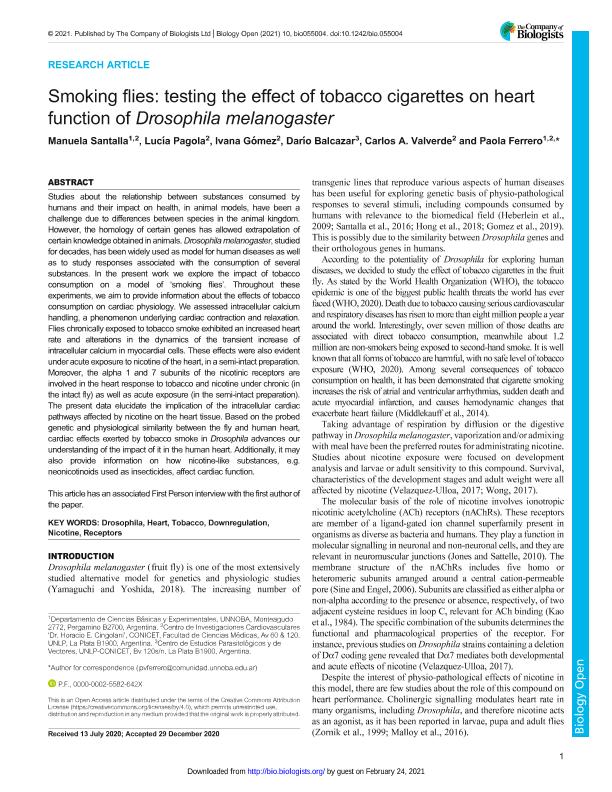Mostrar el registro sencillo del ítem
dc.contributor.author
Santalla, Manuela

dc.contributor.author
Pagola, Lucia Elena

dc.contributor.author
Gómez, Ivana María

dc.contributor.author
Balcazar, Dario Emmanuel

dc.contributor.author
Valverde, Carlos Alfredo

dc.contributor.author
Ferrero, Paola Viviana

dc.date.available
2022-12-15T13:28:54Z
dc.date.issued
2021-02
dc.identifier.citation
Santalla, Manuela; Pagola, Lucia Elena; Gómez, Ivana María; Balcazar, Dario Emmanuel; Valverde, Carlos Alfredo; et al.; Smoking flies: Testing the effect of tobacco cigarettes on heart function of Drosophila melanogaster; The Company of Biologists Ltd; Biology Open; 10; 2; 2-2021; 1-12
dc.identifier.issn
2046-6390
dc.identifier.uri
http://hdl.handle.net/11336/181287
dc.description.abstract
Studies about the relationship between substances consumed by humans and their impact on health, in animal models, have been a challenge due to differences between species in the animal kingdom. However, the homology of certain genes has allowed extrapolation of certain knowledge obtained in animals. Drosophila melanogaster, studied for decades, has been widely used as model for human diseases as well as to study responses associated with the consumption of several substances. In the present work we explore the impact of tobacco consumption on a model of 'smoking flies'. Throughout these experiments, we aim to provide information about the effects of tobacco consumption on cardiac physiology. We assessed intracellular calcium handling, a phenomenon underlying cardiac contraction and relaxation. Flies chronically exposed to tobacco smoke exhibited an increased heart rate and alterations in the dynamics of the transient increase of intracellular calcium in myocardial cells. These effects were also evident under acute exposure to nicotine of the heart, in a semi-intact preparation. Moreover, the alpha 1 and 7 subunits of the nicotinic receptors are involved in the heart response to tobacco and nicotine under chronic (in the intact fly) as well as acute exposure (in the semi-intact preparation). The present data elucidate the implication of the intracellular cardiac pathways affected by nicotine on the heart tissue. Based on the probed genetic and physiological similarity between the fly and human heart, cardiac effects exerted by tobacco smoke in Drosophila advances our understanding of the impact of it in the human heart. Additionally, it may also provide information on how nicotine-like substances, e.g. neonicotinoids used as insecticides, affect cardiac function.
dc.format
application/pdf
dc.language.iso
eng
dc.publisher
The Company of Biologists Ltd
dc.rights
info:eu-repo/semantics/openAccess
dc.rights.uri
https://creativecommons.org/licenses/by-nc-sa/2.5/ar/
dc.subject
DOWNREGULATION
dc.subject
DROSOPHILA
dc.subject
HEART
dc.subject
NICOTINE
dc.subject
RECEPTORS
dc.subject
TOBACCO
dc.subject.classification
Otros Tópicos Biológicos

dc.subject.classification
Ciencias Biológicas

dc.subject.classification
CIENCIAS NATURALES Y EXACTAS

dc.title
Smoking flies: Testing the effect of tobacco cigarettes on heart function of Drosophila melanogaster
dc.type
info:eu-repo/semantics/article
dc.type
info:ar-repo/semantics/artículo
dc.type
info:eu-repo/semantics/publishedVersion
dc.date.updated
2022-09-21T13:52:04Z
dc.journal.volume
10
dc.journal.number
2
dc.journal.pagination
1-12
dc.journal.pais
Reino Unido

dc.journal.ciudad
Cambridge
dc.description.fil
Fil: Santalla, Manuela. Universidad Nacional del Noroeste de la Provincia de Buenos Aires; Argentina. Consejo Nacional de Investigaciones Científicas y Técnicas. Centro Científico Tecnológico Conicet - La Plata. Centro de Investigaciones Cardiovasculares "Dr. Horacio Eugenio Cingolani". Universidad Nacional de La Plata. Facultad de Ciencias Médicas. Centro de Investigaciones Cardiovasculares "Dr. Horacio Eugenio Cingolani"; Argentina
dc.description.fil
Fil: Pagola, Lucia Elena. Consejo Nacional de Investigaciones Científicas y Técnicas. Centro Científico Tecnológico Conicet - La Plata. Centro de Investigaciones Cardiovasculares "Dr. Horacio Eugenio Cingolani". Universidad Nacional de La Plata. Facultad de Ciencias Médicas. Centro de Investigaciones Cardiovasculares "Dr. Horacio Eugenio Cingolani"; Argentina
dc.description.fil
Fil: Gómez, Ivana María. Consejo Nacional de Investigaciones Científicas y Técnicas. Centro Científico Tecnológico Conicet - La Plata. Centro de Investigaciones Cardiovasculares "Dr. Horacio Eugenio Cingolani". Universidad Nacional de La Plata. Facultad de Ciencias Médicas. Centro de Investigaciones Cardiovasculares "Dr. Horacio Eugenio Cingolani"; Argentina
dc.description.fil
Fil: Balcazar, Dario Emmanuel. Consejo Nacional de Investigaciones Científicas y Técnicas. Centro Científico Tecnológico Conicet - La Plata. Centro de Estudios Parasitológicos y de Vectores. Universidad Nacional de La Plata. Facultad de Ciencias Naturales y Museo. Centro de Estudios Parasitológicos y de Vectores; Argentina
dc.description.fil
Fil: Valverde, Carlos Alfredo. Consejo Nacional de Investigaciones Científicas y Técnicas. Centro Científico Tecnológico Conicet - La Plata. Centro de Investigaciones Cardiovasculares "Dr. Horacio Eugenio Cingolani". Universidad Nacional de La Plata. Facultad de Ciencias Médicas. Centro de Investigaciones Cardiovasculares "Dr. Horacio Eugenio Cingolani"; Argentina
dc.description.fil
Fil: Ferrero, Paola Viviana. Universidad Nacional del Noroeste de la Provincia de Buenos Aires; Argentina. Consejo Nacional de Investigaciones Científicas y Técnicas. Centro Científico Tecnológico Conicet - La Plata. Centro de Investigaciones Cardiovasculares "Dr. Horacio Eugenio Cingolani". Universidad Nacional de La Plata. Facultad de Ciencias Médicas. Centro de Investigaciones Cardiovasculares "Dr. Horacio Eugenio Cingolani"; Argentina
dc.journal.title
Biology Open
dc.relation.alternativeid
info:eu-repo/semantics/altIdentifier/url/http://bio.biologists.org/lookup/doi/10.1242/bio.055004
dc.relation.alternativeid
info:eu-repo/semantics/altIdentifier/doi/http://dx.doi.org/10.1242/bio.055004
Archivos asociados
